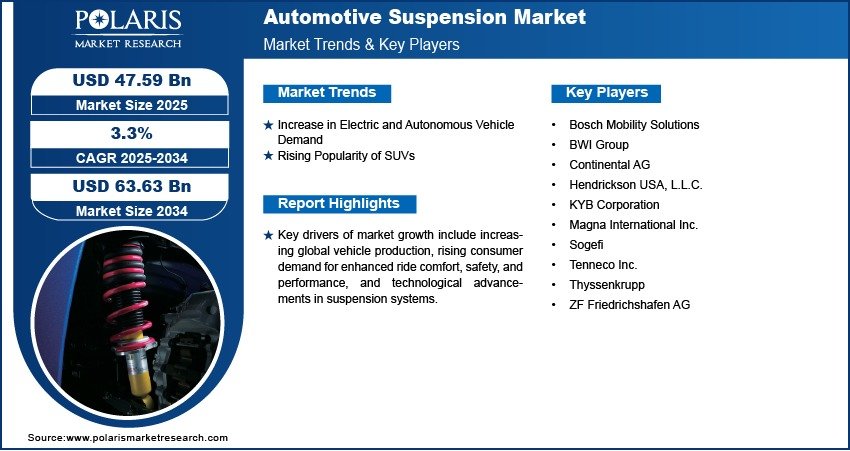Automotive Suspension Market Projected to Reach USD 63.63 Billion By 2034, Growing at a CAGR of 3.3%

The global Automotive Suspension market size was valued at USD 46.17 billion in 2024 and is projected to grow from USD 47.59 billion in 2025 to USD 63.63 billion by 2034 , exhibiting a Compound Annual Growth Rate (CAGR) of 3.3% during the forecast period from 2025 to 2034 .
- Rising Demand for Enhanced Ride Comfort and Vehicle Stability: With increasing consumer preference for comfort and safety, automotive manufacturers are focusing on advanced suspension systems that offer improved ride quality and better handling performance.
- Growth in Electric and Autonomous Vehicles: The rise of electric vehicles (EVs) and autonomous driving technologies is driving demand for adaptive and air suspension systems that provide smoother rides and accommodate heavier battery loads.
- Technological Advancements in Suspension Systems: Innovations such as active and semi-active suspensions, magnetorheological dampers, and electronic control units (ECUs) are enhancing vehicle dynamics and fuel efficiency.
- Increasing Aftermarket Sales: As vehicle ownership rises globally, especially in emerging economies, there is a growing demand for replacement and upgraded suspension components through the aftermarket.
- Stringent Government Regulations on Vehicle Safety and Emissions: Regulatory mandates promoting safer and more energy-efficient vehicles are encouraging the adoption of advanced suspension technologies that reduce road noise, vibration, and harshness (NVH).
- Market Size in 2024 – USD 46.17 billion
- Market Size in 2025 – USD 47.59 billion
- Projected Market Size by 2034 – USD 63.63 billion
- CAGR (2025–2034) – 3.3%
Automotive suspension systems are critical components that connect a vehicle to its wheels, providing both comfort and control by absorbing shocks from road irregularities. These systems include springs, shock absorbers, linkages, and other mechanisms that ensure stability, handling, and passenger comfort.
The market is being driven by rising vehicle production, growing consumer demand for premium features, and technological advancements in suspension design. Additionally, the shift toward electric and luxury vehicles—many of which incorporate advanced suspension systems—is further fueling market growth.






